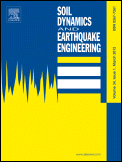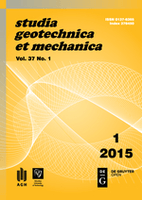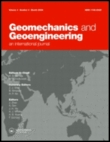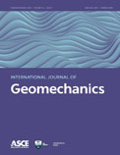
JOURNAL OF GEOTECHNICAL AND GEOENVIRONMENTAL ENGINEERING
Scope & Guideline
Innovating the Intersection of Soil Science and Environmental Stewardship
Introduction
Aims and Scopes
- Geotechnical Engineering:
The journal emphasizes the study of soil mechanics, including the behavior of saturated and unsaturated soils under various loading conditions, and the design and analysis of foundations, retaining structures, and slopes. - Geoenvironmental Engineering:
Research aimed at understanding the interactions between geological materials and environmental factors, including contamination, waste management, and remediation strategies. - Innovative Materials and Techniques:
Exploration of new materials such as biocement and microbial-induced calcite precipitation, as well as advanced techniques like machine learning and numerical modeling in geotechnical applications. - Seismic and Dynamic Analysis:
Focus on the seismic response of structures and foundations, including liquefaction studies, cyclic loading effects, and dynamic soil-structure interaction. - Field and Laboratory Testing:
Development and application of experimental methods to assess soil properties and behavior, including centrifuge modeling and in situ testing techniques. - Sustainable Practices in Geotechnics:
Research promoting sustainability through innovative solutions for soil stabilization, erosion control, and effective waste management in geotechnical projects.
Trending and Emerging
- Microbial-Induced Ground Improvement:
Research into microbial-induced calcite precipitation (MICP) and its applications for soil stabilization and erosion control is gaining popularity, highlighting the intersection of biotechnology and geotechnics. - Machine Learning Applications:
The integration of machine learning techniques in geotechnical analysis, including predictive modeling for soil behavior and risk assessment, is emerging as a significant trend, enhancing the predictive capabilities within the field. - Sustainable and Green Engineering Solutions:
There is a growing focus on sustainability and environmentally friendly practices in geotechnical engineering, including the use of recycled materials and biopolymers, reflecting a commitment to reducing the ecological footprint of engineering projects. - Advanced Numerical and Computational Methods:
The application of advanced numerical modeling techniques, such as the Material Point Method (MPM) and discrete element modeling (DEM), is becoming more prevalent, facilitating complex analyses of soil behavior under various conditions. - Seismic Resilience and Risk Mitigation:
Increasing attention is being paid to the seismic performance of geotechnical structures and the development of methodologies for assessing and mitigating seismic risks, particularly in liquefiable soils.
Declining or Waning
- Traditional Soil Mechanics:
Although foundational, the focus on classical soil mechanics concepts without integration of modern techniques or sustainability considerations seems to be waning, as more innovative and interdisciplinary approaches gain traction. - Conventional Liquefaction Models:
Traditional models for predicting liquefaction are being supplemented or replaced by more advanced methodologies, such as probabilistic and data-driven predictions, indicating a shift away from older approaches. - Geotechnical Case Histories:
While case studies remain valuable, there appears to be a decreasing frequency of purely descriptive case histories, with a stronger emphasis now on analytical and numerical investigations that provide broader insights. - Basic Laboratory Testing Methods:
Standard testing methods, such as conventional triaxial tests, are being overshadowed by more complex, innovative testing approaches that integrate advanced materials and environmental conditions.
Similar Journals

Acta Geotechnica
Charting New Frontiers in Geotechnical EngineeringActa Geotechnica, published by SPRINGER HEIDELBERG, is a leading journal in the field of earth sciences and geotechnical engineering, renowned for its rigorous peer-review process and innovative research contributions. With an impressive impact factor and a notable position in the 2023 Category Quartiles as Q1 in both Earth and Planetary Sciences (miscellaneous) and Geotechnical Engineering and Engineering Geology, this journal is pivotal for professionals and academics alike, providing insights that push the boundaries of geotechnical research. The journal features a diverse range of articles, spanning from foundational studies to the latest advancements in sustainable geotechnical practices, making it an essential resource for researchers, practitioners, and students committed to understanding and solving complex geological challenges. The Scopus ranks further affirm its influence, placing it in the 95th and 92nd percentiles of its categories. With no open access options as of now, subscribers gain exclusive access to trailblazing studies aimed at enhancing geotechnical understanding and application globally.

SOIL DYNAMICS AND EARTHQUAKE ENGINEERING
Advancing the Science of Soil and Seismic ResilienceSOIL DYNAMICS AND EARTHQUAKE ENGINEERING is a premier academic journal published by ELSEVIER SCI LTD, focusing on the intersection of civil and structural engineering, geotechnical engineering, and soil science. Since its inception in 1986, the journal has established itself as a critical resource for advancing knowledge in these fields over nearly four decades, with a remarkable Q1 ranking in 2023 across multiple categories, including Civil and Structural Engineering, Geotechnical Engineering, and Soil Science. The journal’s impactful research, reflected in its high Scopus ranks, serves as a vital reference for both professionals and academics dedicated to understanding soil dynamics and mitigating earthquake hazards. Although it currently does not offer open access, the journal's rigorous peer-review process ensures that published articles provide substantial contributions to the understanding of soil behavior under seismic conditions. Whether you are a researcher, a practitioner, or a student, SOIL DYNAMICS AND EARTHQUAKE ENGINEERING offers essential insights and innovative methodologies pivotal for advancing your work in soil dynamics and earthquake engineering.

Journal of the Korean Geosynthetic Society
Fostering Collaboration in Geosynthetic Science and PracticeJournal of the Korean Geosynthetic Society, published by the Korean Geosynthetic Society, is an essential platform dedicated to advancing the field of geosynthetics, a critical area of civil engineering and environmental science. With a focus on innovative materials and applications that contribute to sustainable infrastructure and environmental protection, this journal actively encourages submissions from researchers and practitioners worldwide. Although currently not indexed by Impact Factor systems, the journal's commitment to rigorous peer-review ensures the dissemination of high-quality research and practical insights that drive the field forward. The journal publishes a range of articles including experimental studies, theoretical analyses, and case studies, making it a valuable resource for engineers, researchers, and students alike, fostering collaboration and knowledge sharing within the geosynthetic community. The journal is accessible at http://www.kgs.org. Join us in shaping the future of geosynthetic technology through your contributions!

Studia Geotechnica et Mechanica
Advancing Geotechnical Knowledge for a Sustainable FutureStudia Geotechnica et Mechanica is a distinguished academic journal dedicated to the vital fields of geotechnics, civil engineering, and materials science. Published by SCIENDO, this Open Access journal has been facilitating unrestricted access to research since 2012, allowing for wide dissemination of innovative findings and methodologies. Based in Poland, it contributes significantly to the scholarly community by providing a platform for the exchange of ideas, techniques, and advancements relevant to Civil and Structural Engineering, Geotechnical Engineering, and related disciplines. With an increasing emphasis on applied research, Studia Geotechnica et Mechanica is classified in various quartiles, demonstrating its emerging influence in fields such as Computers in Earth Sciences and Mechanics of Materials. The journal is indexed in Scopus, showcasing its commitment to maintaining high academic standards. By publishing peer-reviewed research articles, this journal is essential for researchers, professionals, and students looking to stay at the forefront of developments in these critical areas of engineering and science.

CANADIAN GEOTECHNICAL JOURNAL
Pioneering Research in Soil Mechanics and Engineering GeologyCanadian Geotechnical Journal, published by Canadian Science Publishing, stands as a premier resource in the field of geotechnical engineering, focusing on the science and practice of soil mechanics, engineering geology, and related disciplines. Established in 1968, this esteemed journal has earned a distinguished reputation, holding a Q1 ranking in both Civil and Structural Engineering as well as Geotechnical Engineering and Engineering Geology as of 2023. It features a rigorous peer-review process that ensures the publication of high-quality research, making it essential reading for researchers, professionals, and students alike. With an impressive Scopus rank of #63 out of 379 in Civil and Structural Engineering and #41 out of 229 in Geotechnical Engineering, the journal continues to contribute significantly to the advancement of knowledge in geotechnics. While the journal does not currently provide open access options, it remains a vital platform for disseminating innovative findings and fostering academic collaboration in the geotechnical community.

Geotechnical Engineering
Connecting Researchers and Practitioners in Geotechnical EngineeringGeotechnical Engineering, published by the Southeast Asian Geotechnical Society, is a prominent journal dedicated to the field of geotechnical and civil engineering. With its ISSN of 0046-5828, this journal serves as a vital platform for researchers and practitioners to disseminate innovative findings and explore new methodologies within the discipline. Although currently listed in the Q4 quartile across both Civil and Structural Engineering and Geotechnical Engineering categories, Geotechnical Engineering is committed to fostering rigorous scholarship and community engagement in the dynamic field of geotechnical sciences. The journal covers a wide range of topics, providing an important resource for the engineering community. While it does not offer open access, it facilitates significant contributions that enhance the understanding and practice of geotechnical engineering in Southeast Asia and beyond, underscoring its vital role as a knowledge hub for researchers, professionals, and students alike.

Geomechanics and Geoengineering-An International Journal
Navigating the Complexities of Earth SciencesGeomechanics and Geoengineering-An International Journal, published by Taylor & Francis Ltd, serves as a prominent platform for the dissemination of innovative research and advancements in the fields of Geotechnical Engineering and Engineering Geology. With an ISSN of 1748-6025 and E-ISSN of 1748-6033, this journal has established itself as a critical resource within its category, ranking in the Q2 quartile according to the 2023 metrics and positioning itself in the top 38% of the Scopus rankings for Earth and Planetary Sciences. Geomechanics and Geoengineering encompasses a diverse range of topics, including but not limited to soil mechanics, foundation engineering, rock mechanics, and environmental geotechnics, ultimately aiming to advance both theoretical and practical knowledge in these vital areas. This journal not only highlights pioneering research but also facilitates a platform for academia and industry practitioners to collaborate and exchange ideas. While it does not offer open access, it remains a valuable resource for institutions and individuals committed to enhancing their expertise in the geotechnical domain. With convergence years spanning from 2006 to 2024, this journal is equipped to significantly contribute to the evolving landscape of geomechanical research.

International Journal of Geomechanics
Shaping the future of soil science and engineering geology.The International Journal of Geomechanics, proudly published by the American Society of Civil Engineers (ASCE), stands as a pivotal cornerstone in the fields of geotechnical engineering, engineering geology, and soil science. With an esteemed Q1 ranking in both geotechnical engineering and soil science as of 2023, it represents a high-impact platform (impact factor information to be inferred as impressive given the rankings and prominence in the field). Since its inception in 2001, this journal has been committed to advancing the understanding of geomechanical processes, offering a vital forum for researchers, professionals, and students to disseminate innovative findings and practical applications. The journal is indexed by Scopus, holding an impressive position at rank #48 out of 229 in its disciplines, illustrating its significance and influence in the academic community. Although it does not currently offer open access, the journal continues to attract a diverse readership with its critical insights into soil behavior, earth structures, and various geotechnical challenges. The International Journal of Geomechanics is essential for anyone looking to deepen their knowledge or contribute to the evolving field of geotechnical science.

Soil Mechanics and Foundation Engineering
Unlocking the Secrets of Soil Mechanics for Future GenerationsSoil Mechanics and Foundation Engineering, published by SPRINGER, is a prestigious academic journal dedicated to the dynamic fields of soil mechanics and foundation engineering. With a history spanning from 1964 to 2024, this journal serves as a vital platform for researchers, professionals, and students looking to advance their knowledge and explore innovative techniques in soil behavior, foundation design, and geotechnical engineering. Although the journal does not currently operate under an open access model, it remains essential for its contributions to key disciplines, notably in energy, geotechnical engineering, ocean engineering, soil science, and water science. Positioning itself in the third quartile of various categories in the 2023 rankings, it reflects a commitment to maintaining rigorous research standards despite its competitive environment. The unique intersection of its scope allows for multidisciplinary collaboration, making it an invaluable resource for those aiming to tackle the challenges in foundation systems and soil interactions in diverse engineering applications.

Transportation Infrastructure Geotechnology
Exploring the Nexus of Geotechnology and Civil Engineering.Transportation Infrastructure Geotechnology, an esteemed journal published by SpringerNature, serves as a vital platform in the fields of Civil and Structural Engineering, Environmental Engineering, Geotechnical Engineering, and Transportation. Established in 2014 and spanning a decade of significant scientific discourse, this journal has gained recognition for its robust contribution to the understanding of the interplay between geotechnical processes and transportation infrastructure. With an impactful Q2 ranking in multiple categories—including Civil and Structural Engineering and Environmental Engineering—it emphasizes innovative research and practical applications globally. Researchers and professionals can explore critical topics that influence infrastructure sustainability, safety, and efficiency. Although it operates under a subscription model, its affiliation with SpringerNature ensures rigorous peer-review and high-quality publications, making it an indispensable resource for academics and industry experts alike.